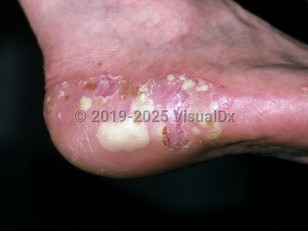Palmoplantar pustulosis in Child
Alerts and Notices
Important News & Links
Synopsis

Known risk factors for the development of palmoplantar pustulosis include stress and smoking. Other associated diseases include psoriasis vulgaris, arthritis (psoriatic arthritis with prevalence of 10%-25%), SAPHO syndrome (synovitis, acne, pustulosis, hyperostosis, and osteitis), thyroid dysfunction (prevalence of 20%-40% and more commonly seen in women), and metabolic syndrome.
Palmoplantar pustulosis may occur alongside or follow a systemic infection. Poststreptococcal pustulosis occurring in the setting of group A streptococcal infection has been reported, responding to high-potency topical steroids along with treatment of the underlying infection. Other postinfectious etiologies that have been reported include odontogenic infections, upper respiratory infections, and Helicobacter pylori infections. Tumor necrosis factor (TNF)-alpha inhibitors, notably, have been implicated in the development of palmoplantar pustular lesions when used to treat psoriasis or inflammatory bowel disease. Only a minority of these patients demonstrate classic plaque psoriasis elsewhere. Metal allergy has also been associated with palmoplantar pustulosis.
Codes
L40.3 – Pustulosis palmaris et plantaris
SNOMEDCT:
27520001 – Pustular psoriasis of palms and soles
Look For
Subscription Required
Diagnostic Pearls
Subscription Required
Differential Diagnosis & Pitfalls

Subscription Required
Best Tests
Subscription Required
Management Pearls
Subscription Required
Therapy
Subscription Required
Drug Reaction Data
Subscription Required
References
Subscription Required
Last Updated:11/18/2020

